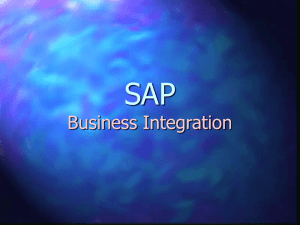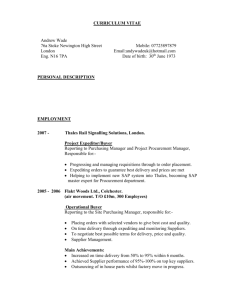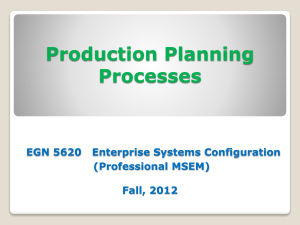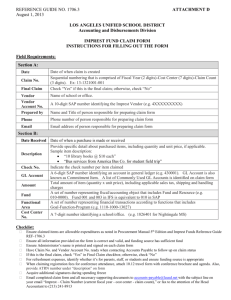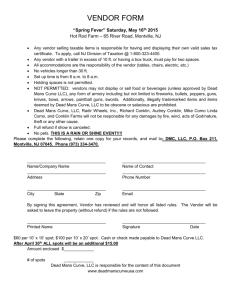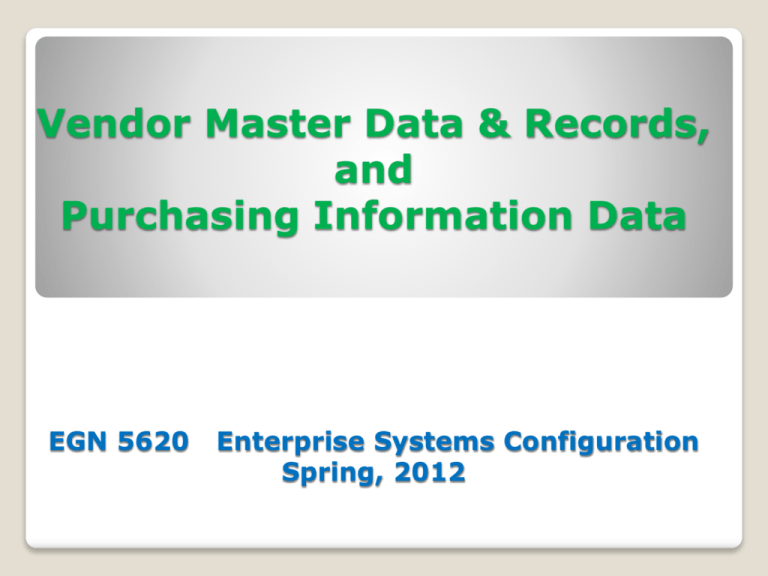
Vendor Master Data & Records,
and
Purchasing Information Data
EGN 5620
Enterprise Systems Configuration
Spring, 2012
Vendor Master Data & Records,
and
Purchasing Information Data
Theories & Concepts
Receiving
and
Inspection
Raw
Materials,
Parts, and
In-process
WareHousing
Production
Finished
Goods
Warehousing
Inspection,
Packaging,
And
Shipping
Materials Management
Purchasing
Production
Control
Physical materials flow
Information flow
Warehousing and Shipping
Inventory Control and Traffic
Customers
Suppliers
Supply Chain Management
in a Manufacturing Plant
Purchasing Process
Material Requisition
Request for Quotations
Select Best Supplier
Purchase Order
Receive and Inspect Goods
From any department,
to purchasing
From purchasing,
to potential suppliers
Based on quality, price,
lead time, dependability
From purchasing,
to selected supplier
From supplier, to receiving,
quality control, warehouse
Mission of Purchasing
Organization
It develops purchasing plans for each
major product or service that are
consistent with operations strategies:
◦
◦
◦
◦
Lower production costs
Faster and on-time deliveries
Higher quality products and services
Flexibility
Purchasing Management
Maintain data base of available, qualified
suppliers
Qualify and select suppliers to supply
each material
Negotiate contracts with suppliers
Act as interface between company and
suppliers
Provide training to suppliers on latest
technologies
Purchasing
Factors contributing to the importance of
purchasing today:
◦ Focus on core business
Up to 60-70% of each sales dollar is paid to
material suppliers
Great impact of material costs on profit
◦ Popular use of just-in-time concept
Supply deliveries must be exact in timing,
quantity, and quality
◦ Globalization
Geographically “stretched-out” supply chain
◦ Intensified competition for scarce resources
Justifications for Centralized
Purchasing
Buying in large quantities
better prices
More clout with suppliers
greater supply continuity
Larger purchasing department
buyer specialization
Combining small orders
less order cost duplication
Combining shipments
lower transportation costs
Better overall control
Buyers’ Duties
Know the market for their commodities
Understand the laws.... tax, contract,
patent..…
Process purchase requisitions and
quotation requests
Make supplier selections
Negotiate prices and conditions of sale
Place and follow-up on purchase orders
Maintain ethical behavior
Types of Buyer/Supplier Relationships
Antagonistic
◦ Parties view each other as the enemy (lose/lose)
Adversarial
◦ Each party attempts to maximize their gain
(win/lose)
Cooperative
◦ Parties understand the benefits of working
together (win/win)
Collaborative
◦ Parties look for opportunities to create value
(win/win)
January 2008
© SAP AG - University Alliances and
The Rushmore Group, LLC 2008. All
rights reserved.
10
A paradigm shift in purchasing
practice
1970 and before
◦ Open bidding
◦ Select the lowest price
1980
◦ Open bidding
◦ Select the best value
1990
◦ Solicit bids from qualified vendors
◦ Select the best value
2000 & beyond
◦ Build/grow long term partnership
Improve supplier’s product/process quality and delivery
commitment
Share profit/price
◦ Form supply chains
Trend in Buyer/Supplier Relationships
Traditional purchasing process tends to
◦ Create an environment of mistrust and low
bidder mentality,
◦ Leading to higher total purchasing costs
Trend is
◦ Collaborative partnership
◦ To establish long term product/service supply
contact agreements
◦ Via identifying, qualifying, and cultivating
longer term suppliers/partners
January 2008
© SAP AG - University Alliances and
The Rushmore Group, LLC 2008. All
rights reserved.
12
Benefits of Managing the
Supply Base
Contract with only world-class suppliers
The fewer suppliers, the lower the
purchasing overhead
Purchasing can pursue strategic sourcing
issues, instead of clerical functions
Streamline the supply chain
Improve overall quality
Improve delivery performance
January 2008
© SAP AG - University Alliances and
The Rushmore Group, LLC 2008. All
rights reserved.
13
Process for building a supply base
1.
2.
3.
4.
5.
6.
Identify need for long term supplier
contract (agreement)
Determine specific sourcing requirements
Identify potential suppliers
Determine method of evaluating suppliers
Select supplier for contract (agreement)
Negotiate and execute contract
(agreement)
January 2008
© SAP AG - University Alliances and
The Rushmore Group, LLC 2008. All
rights reserved.
14
Supplier Evaluation and Selection
A critical step is to identify and evaluate
potential suppliers
It usually involves supplier development
aiming to
◦ Develop partnership with good (product quality) suppliers
◦ Improve total cost and delivery performance of purchased
materials and services
Qualification process includes
◦ Vendor’s qualification
◦ Vendor’s product/service qualification (vendor sub-range)
January 2008
© SAP AG - University Alliances and
The Rushmore Group, LLC 2008. All
rights reserved.
15
Outline Agreement
Long-term purchase agreements
Can be divided into the types below:
◦ Contracts
◦ Scheduling agreements
Can be subject to a release (approval or
clearance) procedure
January 2008
© SAP AG - University Alliances and
The Rushmore Group, LLC 2008. All
rights reserved.
16
Contract Management
Track supplier performance using metrics
for
◦
◦
◦
◦
◦
On-time delivery
Material and/or service quality
Returned materials
Expedite issues
Pricing analysis
Resolve problems
Engage in continuous improvement
process
Terminate/renew contract agreement
January 2008
© SAP AG - University Alliances and
The Rushmore Group, LLC 2008. All
rights reserved.
17
Contracting Questions
How will potential suppliers be evaluated
and selected?
What procedures will be required to
manage the contracts (and suppliers)?
How will performance be measured?
How many are too many suppliers?
◦
◦
◦
◦
◦
Too many suppliers cost money
Supplier integration
Collaborative agreements
Supplier development
Without material production shuts down
What is the risk?
January 2008
© SAP AG - University Alliances and
The Rushmore Group, LLC 2008. All
rights reserved.
18
Creating a Contract
Is a long-term agreement with a vendor
to provide a material or service
◦ For an agreed upon period of time
◦ At a negotiated price or quantity
Can be created manually or with reference
to purchase requisition, Request for Quote
(RFQ)/quotation etc.
January 2008
© SAP AG - University Alliances and
The Rushmore Group, LLC 2008. All
rights reserved.
19
Contract types
Quantity contract
◦ Agreement with a particular vendor to purchase
a specific quantity of materials.
Example: Target quantity of 50,000 meters of
electrical wire at $2/meter. (MK)
Value contract
◦ Similar to quantity contract except the
agreement is to purchase an established
monetary value of materials.
Example: Target value of $100,000 for electrical
wire. (WK)
January 2008
© SAP AG - University Alliances and
The Rushmore Group, LLC 2008. All
rights reserved.
20
Vendor Master Data & Records, and
Purchasing Information Data
SAP Implementation
Vendor Master Data
Includes all data required for
◦ processing business transactions and
◦ corresponding with vendors
Information is shared between the
◦ accounting and
◦ purchasing departments
January 2008
© SAP AG - University Alliances and
The Rushmore Group, LLC 2008. All
rights reserved.
22
Vendor Master Data & Records,
and Purchasing Information Data
Vendor master data and records are
maintained by both
◦ accounts payable (A/P) and
◦ purchasing
Purchasing information data are
maintained primarily by
◦ purchasing
January 2008
© SAP AG - University Alliances and
The Rushmore Group, LLC 2008. All
rights reserved.
23
Vendor Master Data
A master record must be created for
every vendor
◦ General data,
◦ Company Code data (Financial Accounting FI), and
◦ Purchasing data (Material Management - MM)
General data
Address
Control data
Payment
transactions
Company code data
Account management
Payment
transactions
January 2008
Purchasing data
Condition
Control data
Partner functions
© SAP AG - University Alliances and
The Rushmore Group, LLC 2008. All
rights reserved.
24
Vendor Master Data Structure
General Data
Company Code Data
Financial Accounting (FI)
Vendor 10001
Purchasing Data (MM)
January 2008
© SAP AG - University Alliances and
The Rushmore Group, LLC 2008. All
rights reserved.
25
Vendor Master Data – Typical
Screen
Vendor attributes that sufficiently
differentiate them by their:
Address
Control
Payment Transactions
Accounting Information
Correspondence
Purchasing Data
Partner Functions
January 2008
© SAP AG - University Alliances and
The Rushmore Group, LLC 2008. All
rights reserved.
26
Vendor Master
General Data – Address
General Data – Address
Address
Vendor Name
Search Term
Street address
City, Region Postal code
Country
Communication
Language
Telephone, Fax, E-Mail
January 2008
© SAP AG - University Alliances and
The Rushmore Group, LLC 2008. All
rights reserved.
27
Vendor Master- General Data –
Control Data
Account Control
• Customer (if the vendor is both a vendor and a
customer)
• Authorization
• Trading partner (if the vendor is a part of an
independent company)
• Group key (combines vendors to enhance the
search capacity)
January 2008
© SAP AG - University Alliances and
The Rushmore Group, LLC 2008. All
rights reserved.
28
Vendor Master- General Data –
Control Data
Tax Information
◦ Tax codes
used to enter ID number of the vendor
◦ Fiscal address
◦ Country code
◦ City code
Reference Data / Area
◦ International locator number
used to identify a legal, functional, or physical
location within a business or organizational entity
◦ Industry key
allows similar vendors to be grouped by industry
◦ Transport zone
January 2008
© SAP AG - University Alliances and
The Rushmore Group, LLC 2008. All
rights reserved.
29
Vendor Master - General Data –
Payment Transactions
Bank Details
◦ Bank Key
selected from a match code with company code entered
◦ Bank Account
◦ Account Holder
◦ Partner Bank Type (if vendor has more than one bank
account, then it allows to sequence those accounts)
Payment Transactions
◦ Alternative Payee
used to enter another vendor number
◦ Instruction Key
To control which statements are given to the banks during the
payment order
© SAP AG - University Alliances and
January 2008
The Rushmore Group, LLC 2008. All
rights reserved.
30
Vendor Master – Accounting
Information
Accounting Information
◦ Reconciliation Account
see next slide
◦ Sort Key
used to select a sort for the allocation field
◦ Release Group
the release-approval group can be defined and
configured to allow only those in the group to be
able to “release for payment
January 2008
© SAP AG - University Alliances and
The Rushmore Group, LLC 2008. All
rights reserved.
31
Reconciliation Account
An individual G/L account recorded in line-item
detail in the sub-ledger and summarized in the
G/L
The information entered into the reconciliation
account is all line-item data from the vendor
account.
The reconciliation in the G/L is at the summary
level and is used to reconcile against the vendor
account at the total level, while the sub-ledger
identifies line-item data.
January 2008
© SAP AG - University Alliances and
The Rushmore Group, LLC 2008. All
rights reserved.
32
Reconciliation Account
Postings to sub-ledgers (such as accounts
receivable or accounts payable) are
automatically concurrently posted to the
corresponding reconciliation account in the
General Ledger
Thus, the General Ledger is automatically
updated and remains in balance with the
customer and vendor individual account totals
January 2008
© SAP AG - University Alliances and
The Rushmore Group, LLC 2008. All
rights reserved.
33
General Ledger
Reconciliation Account (continued)
General
Ledger
General Ledger
Reconciliation Accounts
A/R, A/P, GR/IR
Debit Credit
$$ $$
A/R
Debit Credit
$$ $$
A/P
Debit Credit
$$ $$
GR/IR
Debit Credit
$$ $$
Subsidiary
Ledger Accounts
A/R, A/P, GR/IR
January 2008
© SAP AG - University Alliances and
The Rushmore Group, LLC 2008. All
rights reserved.
34
Vendor Master – Accounting
Information
Interest Calculation
◦ Interest Calculation Indication
for automation interest calculation, and is
configured by accounting department
◦ Interest Calculation Frequency
used to select a period for calculation of interest
Withholding Tax
◦ Withholding Tax Code
◦ Exemption Number
January 2008
© SAP AG - University Alliances and
The Rushmore Group, LLC 2008. All
rights reserved.
35
Account Groups
Identifier that controls which fields must
be entered when an account is created
Determine a valid number interval for
each of the groups (types) of General
Ledger accounts that have common
attributes
Must be created before General Ledger
Chart of Accounts master records can be
created
You must assign each account to an
appropriate account group
January 2008
© SAP AG - University Alliances and
The Rushmore Group, LLC 2008. All
rights reserved.
36
Account Groups
Chrt/accts
CHRT
CHRT
CHRT
Acct group
Description
BS
Balance Sheet (BS)
PL
Income Sheet
RA
Reconciliation
January 2008
From
100000
400000
110000
© SAP AG - University Alliances and The Rushmore Group, LLC 2008. All rights
reserved.
To
399999
999999
310000
37
Account Groups
Account Group BS
Account control
Account management
Document entry
Bank/financial details
Interest calculation
Joint venture
Account control
Suppress
Req. entry
Opt. entry
Display
Currency
Tax category
Reconciliation account
…
January 2008
© SAP AG - University Alliances and
The Rushmore Group, LLC 2008. All
rights reserved.
38
Field Status
Field status controls how the data will be
entered for a field when an accounting
master record is being used in a
transaction
Determining whether a field is required,
optional, suppressed, or display only
Field status controls are also relevant to a
specific activity — create, change, or
display
January 2008
© SAP AG - University Alliances and
The Rushmore Group, LLC 2008. All
rights reserved.
39
Field Status Variant
Fld status groupText
ZALL
All Accounts
ZBSA
Balance Sheet Accounts
ZEXP
Expense Accounts
ZGRI
Material Management (GR/IR) Accounts
ZRCN
Reconciliation Accounts
ZREV
Revenue Accounts
January 2008
© SAP AG - University Alliances and
The Rushmore Group, LLC 2008. All
rights reserved.
40
Field Status Variant
Field status variant (V000) - Group ZBSA - Balance Sheet Acct.
General data
Additional account assignments
Materials management
Payment transactions
Asset accounting
Taxes
...
General Data
Suppress
Req. entry
Opt. entry
Assignment number
Text
Invoice reference
…
January 2008
Display
© SAP AG - University Alliances and
The Rushmore Group, LLC 2008. All
rights reserved.
41
Vendor Master – Payment Transactions
Payment Data
◦ Payment Terms (cash discounts and favorable payment
periods offered by vendor)
◦ Tolerance Group (the limit to which an event can deviate)
◦ Check Double Invoice (to check for double or duplicate
invoices when they are entered)
◦ Check Cashing Time
Automatic Payment Transactions
◦ Payment Methods
◦ Alternate Payee
◦ Payment Block(prevent any open items from being paid)
Invoice Verification
◦ Tolerance Group
January 2008
© SAP AG - University Alliances and
The Rushmore Group, LLC 2008. All
rights reserved.
42
Vendor Master –
Correspondence Accounting
Dunning Data
◦ Dunning Procedure
To remind vendors to deliver the material from the purchase orders
◦ Dunning Block
If selected, the vendor is not for dunning run
◦ Dunning Recipient
◦ Date of Legal Dunning Procedure
Correspondence information
◦ Local Processing
◦ Accounting Clerk
◦ Account With Vendor
used to identify the company
◦ Clerk at vendor
the contact person at the vendor side
January 2008
© SAP AG - University Alliances and
The Rushmore Group, LLC 2008. All
rights reserved.
43
Vendor Master –Purchasing Data
Conditions
◦
◦
◦
◦
Order Currency
Terms of Payment
Incoterms (next slide)
Minimum Order Value
Sales Data
◦ Salesperson
◦ Telephone
◦ Account with vendor
January 2008
© SAP AG - University Alliances and
The Rushmore Group, LLC 2008. All
rights reserved.
44
Vendor Master –Purchasing Data
Incoterms
are standard trade definitions used in international
contracts. The International Chamber of Commerce based
in Paris, devised these standard trade definitions. The 13
incoterms are divided into four groups (arrival, departure,
carriage paid by seller, and carriage not paid by seller).
Group
E-Departure
D - Arrival
D - Arrival
D - Arrival
D - Arrival
D - Arrival
C- Paid
C- Paid
C- Paid
C- Paid
F - Unpaid
F - Unpaid
F - Unpaid
Incoterm
EXW
DAF
DES
DEQ
DDU
DDP
CFR
CIF
CPT
CIP
FCA
FAS
FOB
Long Name
Ex work
Delivered at Frontier
Delivered Ex Ship
Delivered Ex Quay
Delivered Duty Unpaid
Delivered Duty Paid
Cost and Freight
Cost, Insurance, Freight
Carriage Paid to
Carriage, Insurance Paid
Free Carrier
Free Alongside Ship
January 2008
Free on Board
Location
Named Place
Named Place
Port of Destination
Port of Destination
Destination
Destination
Port of Destination
Port of Destination
Destination
Destination
Named Place
© SAP AG - University Alliances and
ThePort
Rushmore
Group, LLC 2008. All
of Destination
rights reserved.
Port of Destination
45
Vendor Master –Purchasing Data
• Control Data
• Acknowledgement Required
• To indicate if acknowledgement is required upon receipt of the order
• Automatic Purchase Order
• To allow automatic issuance of purchase order
• Good receipt-based invoice verification
• To perform invoice verification based on the goods receipt amounts
• Subsequent settlement
• To allow a rebate
• Default Data Material
• Purchasing Group
• Planned Delivery Time
• Confirmation control (confirmation type and sequence)
January 2008
© SAP AG - University Alliances and
The Rushmore Group, LLC 2008. All
rights reserved.
46
Vendor Master – Purchasing Data –
Partner Functions
Partner Functions
List of (Vendor) Partner Functions
◦ Used to define the relationships between the
vendor (or customer) and the company.
◦
◦
◦
◦
◦
◦
◦
◦
AZ
CA
CP
ER
GS
OA
PI
VN
alternative payment recipient
contract address
contact person
employee responsible
goods supplier
ordering address
invoice presented by
vendor
© SAP AG - University Alliances and
January 2008
The Rushmore Group, LLC 2008. All
rights reserved.
47
Vendor Master – Purchasing Data
– Account Group
Vendor masters are assigned to a vendor
account group
Through field status maintenance, vendor
account groups can be set up for one-time
vendors, regional vendors, and internal
vendors
The vendor account group controls both
type and number range assignment for
vendors
January 2008
© SAP AG - University Alliances and
The Rushmore Group, LLC 2008. All
rights reserved.
48
Purchasing Info Record
The purchasing info record provides
continuously updated information about
◦ the relationship of a specific material with a
specific vendor
◦ Order unit, price, price changes, tolerances,
reminder information, historic data, statistics,
texts
◦ Choice of automatic or manual updating
January 2008
© SAP AG - University Alliances and
The Rushmore Group, LLC 2008. All
rights reserved.
49
Source List
It stores information about where to
acquire a given material for a given period
of time
It specifies whether this source should be
used by Materials Requirement Planning
(MRP)
January 2008
© SAP AG - University Alliances and
The Rushmore Group, LLC 2008. All
rights reserved.
50
Purchasing Tolerances
A tolerance limit set for allowed variance
before a warning/error message is
displayed
◦ Price variance
Compares the price in the purchase order with the
valuation price stored in the material master
◦ Maximum cash discount
This tolerance limit is set to assure that cash
discounts do not exceed allowable discounts
January 2008
© SAP AG - University Alliances and
The Rushmore Group, LLC 2008. All
rights reserved.
51
Goods Receipts Tolerances
Purchase order price quantity
◦ Two tolerance levels maintained per item
The maximum percentage variance before a goods
receipt postings is not allowed
A percent variance that generates a warning
message but allows posting
Moving average price variance
◦ the maximum moving average price change
allowed
January 2008
© SAP AG - University Alliances and
The Rushmore Group, LLC 2008. All
rights reserved.
52
Invoice Receipts Tolerances
Tolerance limits configured for invoice
receipts: price, quantity, and blanket
purchase orders
The tolerances include:
◦ Amount for item with or without order
reference
◦ Percentage Over/Under Quantity Variance
◦ Exceed amount: quantity variance
◦ Blanket purchase order (value and time limit)
◦ Price variance
January 2008
© SAP AG - University Alliances and
The Rushmore Group, LLC 2008. All
rights reserved.
53
Automatic Account Assignment
Created to avoid manual postings of
financial transactions which follow goods
movements to reflect the values of
transferred materials
Used across all modules to keep track of
the values of materials that are being
consumed (e.g., production), or transferred
into other valuation areas of the company
Is a set of rules and master data which
enable the financial tracking of logistics
movement
January 2008
© SAP AG - University Alliances and
The Rushmore Group, LLC 2008. All
rights reserved.
54
Automatic Account Assignment
Components
Chart of Accounts
Valuation Grouping Code
◦ Example: valuation area is plant, five plants
exist in the company, all five plants use the
same accounts.
◦ Multiple valuation groups are possible
Transaction Key
Modifier for Transaction Key
Valuation Class
January 2008
© SAP AG - University Alliances and
The Rushmore Group, LLC 2008. All
rights reserved.
55
Automatic Account Assignment
Valuation Grouping Code
Grouping Code
G001
Grouping Code
G002
Plant – P001
Plant – P004
Plant – P002
Plant – P005
Plant – P003
January 2008
© SAP AG - University Alliances and
The Rushmore Group, LLC 2008. All
rights reserved.
56
Automatic Account Assignment
Transaction Keys
Transaction Keys
◦ The transaction keys are used to determine
accounts or posting keys for line items which
are created automatically by the system.
◦ The transaction keys are defined in the
system.
January 2008
© SAP AG - University Alliances and
The Rushmore Group, LLC 2008. All
rights reserved.
57
Automatic Account Assignment
Transaction Keys
Transaction
Keys
◦ Inventory Postings
BSX
◦ Offsetting Entry for Inventory Postings
GBB
◦ Materials Management Small Differences
DIF
◦ Cost (price) differences (PPV)
PRD
◦ Goods receipt / inv. receipt clearing acct
WRX
January 2008
© SAP AG - University Alliances and
The Rushmore Group, LLC 2008. All
rights reserved.
58
Automatic Account Assignment
Modifier
Modifier – modifies the transaction key for
various movement types
◦
◦
◦
◦
◦
Blank – Goods receipt from purchase order
with account assignment
VBR – Goods issue to consumption
VAX – Goods issue to sales – post to cost of
goods sold
AUF – Goods receipt from a production order
– post to production settlement
Etc. – Many others
January 2008
© SAP AG - University Alliances and
The Rushmore Group, LLC 2008. All
rights reserved.
59
Material Types & Valuation Classes
Account category reference:
◦ Builds the link between material types and the
valuation class(es)
Material Type
Account Category Reference
Valuation Class
ROH
0001 – Reference for Raw Materials
3000/3001/3002/3003
HIBE
0002 – Reference for Operating Supplies
3030/3031
HAWA
0005 – Reference for Trading Goods
3100
FERT
0009 – Reference for Finished Products
7920
January 2008
© SAP AG - University Alliances and
The Rushmore Group, LLC 2008. All
rights reserved.
60
Material Types & Valuation Classes
Valuation Class
3030
(Supplies)
Valuation Class
3100
(Trading Goods)
Material Type
ROH (Raw Material)
Acct Cat. Ref
0001 – Raw Materials
Valuation Class
3000
(Raw)
Valuation Class
7920
(Finished goods)
January 2008
© SAP AG - University Alliances and
The Rushmore Group, LLC 2008. All
rights reserved.
61
Automatic Account Assignment
Valuation Class
3030 (Supplies Good)
Grouping Code
G_ _ _
Grouping Code
G_ _ _
Goods Movement
GBB (Goods issue)
Goods Movement
GBB (Goods issue)
Account Modifier
Blank (Goods receipt)
Account Modifier
Blank (Goods receipt.)
Account
7210_ _
Plant P_ _ _
Valuation Class
3100 (Trading Good)
Account
7400_ _
January 2008
© SAP AG - University Alliances and
The Rushmore Group, LLC 2008. All
rights reserved.
62
Automatic Account Assignment
Where Valued:
Why 1:
Why 2:
Where Value
is recorded:
Material
Valuation Area
Goods
Movement
Additional
Information
Chart of
Accounts
Represented
By:
Valuation
Class
Valuation
Grouping Code
Transaction
Event Key
Account
Modifier
G/L Account
Points To:
Material Type
Plant
Why 1:
Why 2:
Where Value
is recorded:
From
purchase
order
Chart of
Accounts C000
Blank
7210 _ _
What:
What:
Where Valued:
BPEN_ _ _
Plant – P_ _ _
Good
Receipt
Represented
By:
3100
G_ _ _
GBB
Points To:
HAWA
Plant – P_ _ _
January 2008
© SAP AG - University Alliances and
The Rushmore Group, LLC 2008. All
rights reserved.
63
Vendor Master Data & Records, &
Purchase Information Records
PEN, Inc.
Pen Inc. : Supplies
Vendor Name
Vendor Code
City
State
Zip
code
Promotions Ltd _ _ _
Chico
CA
95929
Slick Pens _ _ _
Milwaukee
WI
53201
Premier Pens _ _ _
Baton Rouge
LA
70803
Boxes inc _ _ _
Sioux Falls
SD
57101
Tanager
Vermillion
SD
57069
Pen Inc. : Vendor Master
Pen Inc. : Purchase
Information Records
Pen Inc. : Source List
Exercises:
89. Set default values for inventory management reservations
90. Maintain purchasing tolerance limits
91. Maintain goods receipt tolerance limits
92. Maintain invoice receipt tolerance limits
93. Set (review) valuation control
94. Assign valuation area grouping
95. Define (review) valuation classes
208. Create labor expense account
209. Create production order settlement account
210. Create production variance account
96. Configure automatic postings for goods movement
97. Configure automatic posting for taxes
98. Set parameters for invoice verification
99. Create default values for invoice verification
173. Create purchasing information records
173a.Create source list

